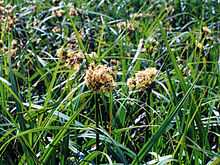Scirpus
| Scirpus | |
|---|---|
 | |
| Scirpus atrovirens | |
| Scientific classification | |
| Kingdom: | Plantae |
| (unranked): | Angiosperms |
| (unranked): | Monocots |
| (unranked): | Commelinids |
| Order: | Poales |
| Family: | Cyperaceae |
| Genus: | Scirpus L. |
| Species | |
|
About 120; see text | |
The plant genus Scirpus consists of a large number of aquatic, grass-like species in the family Cyperaceae (the sedges), many with the common names club-rush or bulrush (see also bulrush for other plant genera so-named). Other common names are deergrass or grassweed. They have grass-like leaves, and clusters of small spikelets, often brown in colour. Some species (e.g. S. lacustris) can reach a height of 3 m, while others (e.g. S. supinus) are much smaller, only reaching 20–30 cm tall.
The genus has a cosmopolitan distribution. Many species are common in wetlands and can produce dense stands of vegetation, along rivers,[1][2] in coastal deltas[3] and in ponds and potholes.[4] Although flooding is the most important factor affecting its distribution, drought, ice scour, grazing, fire and salinity also affect its abundance.[5] It can survive unfavourable conditions like prolonged flooding, or drought, as buried seeds[6]
Scirpus species are often planted to inhibit soil erosion and provide habitat for other wildlife. They are also used in some herbal remedies; the plant's rhizomes are collected in the autumn and winter and dried in the sun before use.
The taxonomy of the genus is complex, and under review by botanists. Recent studies by taxonomists of the Cyperaceae have resulted in the creation of several new genera, including the genera Schoenoplectus and Bolboschoenus; others (including Blysmus, Isolepis, Nomochloa, and Scirpoides) have also been used. At one point this genus held almost 300 species, but many of the species once assigned to it have now been reassigned, and it now holds an estimated 120 species.
Scirpus species are used as food plants by the larvae of some Lepidoptera species, including Batrachedra cuniculata.
- Selected species
- (This list is incomplete, and may include some species now assigned to other genera.)
- Scirpus ancistrochaetus northeastern bulrush
- Scirpus atrocinctus black-girdle bulrush
- Scirpus atrovirens woolgrass bulrush
- Scirpus bicolor
- Scirpus campestris salt marsh bulrush
- Scirpus cespitosus deergrass
- Scirpus congdonii Congdon's bulrush
- Scirpus cyperinus - cottongrass bulrush
- Scirpus diffusus
- Scirpus divaricatus spreading bulrush
- Scirpus expansus Woodland beakrush
- Scirpus flaccidifolius reclining bulrush
- Scirpus fluitans floating club-rush
- Scirpus fluviatilis - river bulrush
- Scirpus georgianus Georgia bulrush
- Scirpus hattorianus bulrush
- Scirpus lineatus drooping bulrush
- Scirpus longii Long's bulrush
- Scirpus mariqueter
- Scirpus microcarpus small-fruit bulrush
- Scirpus mucronatus
- Scirpus nevadensis Nevada bulrush
- Scirpus olneyi Olney bulrush
- Scirpus pacificus Pacific Coast bulrush
- Scirpus pallidus pale bulrush
- Scirpus paludosus salt marsh bulrush
- Scirpus pedicellatus stalked bulrush
- Scirpus pendulus pendulous bulrush
- Scirpus polyphyllus leafy bulrush
- Scirpus pumilus dwarf deergrass
- Scirpus pungens sharp club-rush
- Scirpus radicans
- Scirpus robustus salt marsh bulrush
- Scirpus supinus dwarf club-rush
- Scirpus sylvaticus wood club-rush
- Scirpus triqueter triangular club-rush
- Selected species in a broader view of the genus
- Bolboschoenus maritimus sea club-rush
- Isolepis cernua slender club-rush
- Isolepis setacea bristle club-rush
- Schoenoplectus acutus tule
- Schoenoplectus hudsonianus alpine deergrass
- Schoenoplectus lacustris common club-rush
- Schoenoplectus tabernaemontani
- Scirpoides holoschoenus round-headed club-rush
References
- ↑ Auclair, A. N. D., Bouchard, A. and Pajaczkowski, J. (1976a). Plant standing crop and productivity relations in a Scirpus–Equisetum wetland. Ecology 57: 941–52.
- ↑ Day, R. T., Keddy, P. A., McNeill, J., and Carleton, T. (1988). Fertility and disturbance gradients: a summary model for riverine marsh vegetation. Ecology 69: 1044–54.
- ↑ Gough, L. G., Grace, J. B., and Taylor, K. L. (1994). The relationship between species richness and community biomass: the importance of environmental variables. Oikos 70: 271–9.
- ↑ van der Valk, A. G. (1989). Northern Prairie Wetlands. Ames, IA: Iowa State University Press.
- ↑ Keddy, P.A. (2010). Wetland Ecology: Principles and Conservation (2nd edition). Cambridge University Press, Cambridge, UK.
- ↑ van der Valk, A. G. and Davis, C. B. (1976). The seed banks of prairie glacial marshes. Canadian Journal of Botany 54: 1832–8.
External links
- Genus Scirpus
- Genus Scirpus
- Scirpus (Cyperaceae)
- "What Is 'Schoenoplectus americanus'?" and "Should We Reject The Name 'Scirpus americanus'?"
- Edibility of Scirpus: Edible parts and identification of Scirpus
Sources
- Muntz, Philip A. A California Flora. Berkeley, CA: University of California Press, 1973, copyright 1959
- Muntz, Philip A. A California Flora: Supplement’’. Berkeley, CA: University of California Press, 1976 (Scirpus lacutris, validus, glaucus, p. 183))
| Wikimedia Commons has media related to Scirpus. |